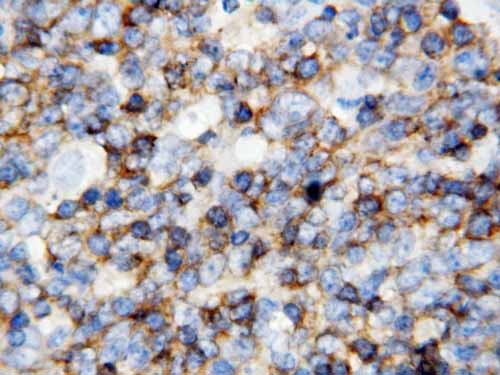Anti-CD45 Antibody
- SPECIFICATION
- CITATIONS
- PROTOCOLS
- BACKGROUND

Application
| WB, IHC-P, ICC |
|---|---|
| Primary Accession | P08575 |
| Host | Rabbit |
| Reactivity | Human |
| Clonality | Polyclonal |
| Format | Lyophilized |
| Description | Rabbit IgG polyclonal antibody for Receptor-type tyrosine-protein phosphatase C(PTPRC) detection. Tested with WB, IHC-P, ICC in Human. |
| Reconstitution | Add 0.2ml of distilled water will yield a concentration of 500ug/ml. |
| Gene ID | 5788 |
|---|---|
| Other Names | Receptor-type tyrosine-protein phosphatase C, 3.1.3.48, Leukocyte common antigen, L-CA, T200, CD45, PTPRC, CD45 |
| Calculated MW | 147254 MW KDa |
| Application Details | Immunocytochemistry , 0.5-1 µg/ml, Human, - Immunohistochemistry(Paraffin-embedded Section), 0.5-1 µg/ml, Human, By Heat Western blot, 0.1-0.5 µg/ml, Human |
| Subcellular Localization | Membrane ; Single-pass type I membrane protein . Membrane raft . Colocalized with DPP4 in membrane rafts. |
| Protein Name | Receptor-type tyrosine-protein phosphatase C |
| Contents | Each vial contains 5mg BSA, 0.9mg NaCl, 0.2mg Na2HPO4, 0.05mg Thimerosal, 0.05mg NaN3. |
| Immunogen | A synthetic peptide corresponding to a sequence at the C-terminus of human CD45(1209-1227aa MVSTFEQYQFLYDVIASTY). |
| Purification | Immunogen affinity purified. |
| Cross Reactivity | No cross reactivity with other proteins |
| Storage | At -20˚C for one year. After r˚Constitution, at 4˚C for one month. It˚Can also be aliquotted and stored frozen at -20˚C for a longer time.Avoid repeated freezing and thawing. |
| Sequence Similarities | Belongs to the protein-tyrosine phosphatase family. Receptor class 1/6 subfamily. |
| Name | PTPRC (HGNC:9666) |
|---|---|
| Synonyms | CD45 |
| Function | Protein tyrosine-protein phosphatase required for T-cell activation through the antigen receptor (PubMed:35767951). Acts as a positive regulator of T-cell coactivation upon binding to DPP4. The first PTPase domain has enzymatic activity, while the second one seems to affect the substrate specificity of the first one. Upon T-cell activation, recruits and dephosphorylates SKAP1 and FYN. Dephosphorylates LYN, and thereby modulates LYN activity (By similarity). |
| Cellular Location | Cell membrane; Single-pass type I membrane protein. Membrane raft. Synapse. Note=Colocalized with DPP4 in membrane rafts. |
| Tissue Location | Isoform 1: Detected in thymocytes. Isoform 2: Detected in thymocytes. Isoform 3: Detected in thymocytes. Isoform 4: Not detected in thymocytes. Isoform 5: Detected in thymocytes. Isoform 6: Not detected in thymocytes. Isoform 7: Detected in thymocytes Isoform 8: Not detected in thymocytes. |

Thousands of laboratories across the world have published research that depended on the performance of antibodies from Abcepta to advance their research. Check out links to articles that cite our products in major peer-reviewed journals, organized by research category.
info@abcepta.com, and receive a free "I Love Antibodies" mug.
Provided below are standard protocols that you may find useful for product applications.
Background
CD45(Cluster of Differentiation 45), also known as PTPRC, LCA or CD45R, is an enzyme that, in humans, is encoded by the PTPRC gene.CD45 is a member of the protein tyrosine phosphatase(PTP) family. CD45 is a major high molecular mass leukocyte cell surface molecule which is also an integral membrane protein tyrosine phosphatase.The cytogenetic location of CD45 is 1q31.3-q32.1. CD45 is especially a prototype for transmembrane protein-tyrosine phosphatase(PTP). Targeted disruption of the CD45 gene leads to enhanced cytokine and interferon receptor-mediated activation of JAKs and STAT proteins. In vitro, CD45 directly dephosphorylates and binds to JAKs. Functionally, CD45 negatively regulates interleukin-3-mediated cellular proliferation, erythropoietin-dependent hematopoiesis, and antiviral responses in vitro and in vivo. CD45 has been best studied in T cells, where it determines T cell receptor signaling thresholds. CD45 is moved into or out of the immunological synapse(IS) membrane microdomain depending on the relative influence of interaction with the extracellular galectin lattice or the intracellular actin cytoskeleton. Galectin interaction can be finetuned by varying usage of the heavily Oglycosylated spliced regions and sialylation of Nlinked carbohydrates.
If you have used an Abcepta product and would like to share how it has performed, please click on the "Submit Review" button and provide the requested information. Our staff will examine and post your review and contact you if needed.
If you have any additional inquiries please email technical services at tech@abcepta.com.













 Foundational characteristics of cancer include proliferation, angiogenesis, migration, evasion of apoptosis, and cellular immortality. Find key markers for these cellular processes and antibodies to detect them.
Foundational characteristics of cancer include proliferation, angiogenesis, migration, evasion of apoptosis, and cellular immortality. Find key markers for these cellular processes and antibodies to detect them. The SUMOplot™ Analysis Program predicts and scores sumoylation sites in your protein. SUMOylation is a post-translational modification involved in various cellular processes, such as nuclear-cytosolic transport, transcriptional regulation, apoptosis, protein stability, response to stress, and progression through the cell cycle.
The SUMOplot™ Analysis Program predicts and scores sumoylation sites in your protein. SUMOylation is a post-translational modification involved in various cellular processes, such as nuclear-cytosolic transport, transcriptional regulation, apoptosis, protein stability, response to stress, and progression through the cell cycle. The Autophagy Receptor Motif Plotter predicts and scores autophagy receptor binding sites in your protein. Identifying proteins connected to this pathway is critical to understanding the role of autophagy in physiological as well as pathological processes such as development, differentiation, neurodegenerative diseases, stress, infection, and cancer.
The Autophagy Receptor Motif Plotter predicts and scores autophagy receptor binding sites in your protein. Identifying proteins connected to this pathway is critical to understanding the role of autophagy in physiological as well as pathological processes such as development, differentiation, neurodegenerative diseases, stress, infection, and cancer.




